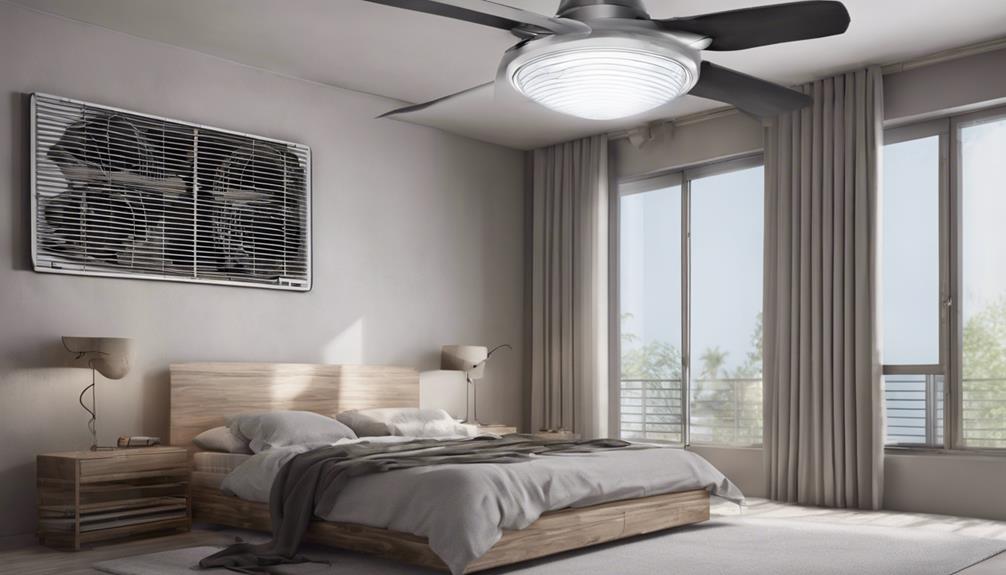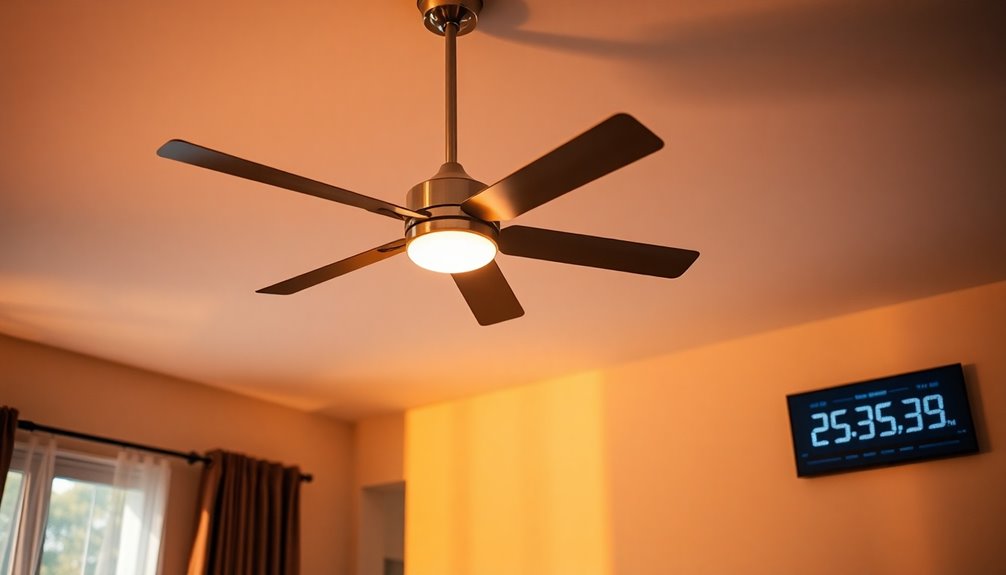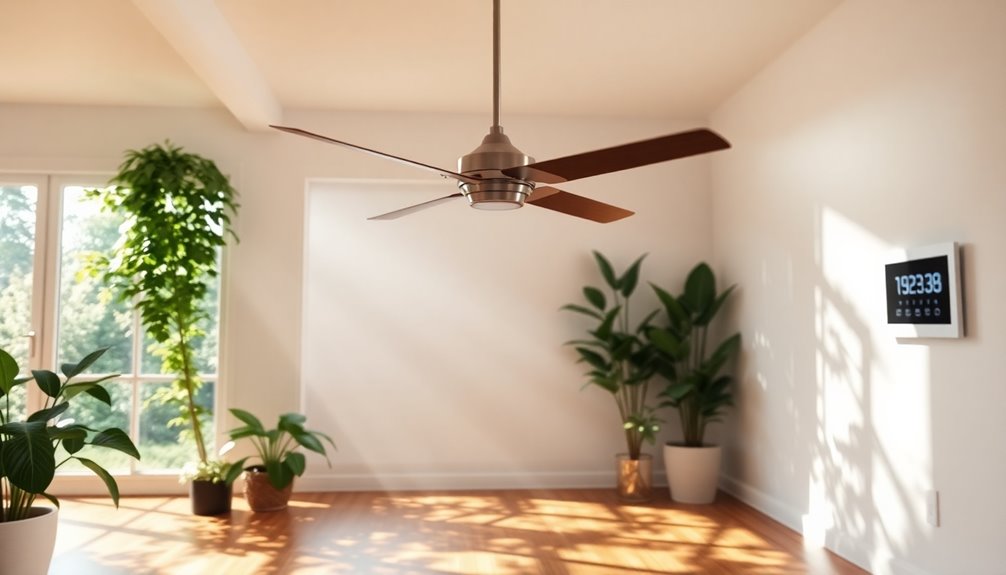Ceiling fans can definitely save energy, especially when paired with your air conditioning. By raising your thermostat by 4°F while using a ceiling fan, you can maintain comfort and reduce your AC's workload. Fans typically use only 30-50 watts, far less than air conditioning units. About 75% of users notice lower electricity bills with regular fan use. Just remember to run fans only in occupied rooms for maximum efficiency. If you want to know more about enhancing your energy savings and optimizing your fan usage, there's plenty more to uncover.
Key Takeaways
- Ceiling fans can reduce cooling costs by up to 12% when used alongside air conditioning.
- Regular use of ceiling fans leads to lower electricity bills for about 75% of consumers.
- Running fans only in occupied rooms prevents unnecessary energy waste.
- ENERGY STAR® certified ceiling fans are 20% more efficient, enhancing energy savings.
- Ceiling fans create a wind-chill effect, allowing for higher thermostat settings and reduced AC runtime.
Benefits of Ceiling Fans

Ceiling fans offer a practical solution for homeowners looking to save on energy costs while maintaining comfort. By using ceiling fans, you can greatly reduce cooling costs—up to 12%—when paired with your air conditioning system. You can raise your thermostat settings by as much as 4°F without sacrificing comfort, which leads to decreased air conditioning runtime. This means you'll enjoy energy savings while still feeling comfortable in your home.
Ceiling fans allow for better air circulation, creating a wind chill effect that makes your rooms feel cooler without actually lowering the temperature. On average, ceiling fans consume only 30-50 watts of energy, much less than traditional air conditioning units, resulting in considerable energy savings. Additionally, incorporating energy-efficient systems into your home can further enhance your savings and comfort levels.
When you incorporate ceiling fans into your cooling strategy, you may find your electricity bills dropping. About 75% of consumers report reduced costs after regular use of ceiling fans.
Optimizing Fan Usage

Maximizing the energy efficiency of your ceiling fan can greatly enhance your comfort while saving on energy costs. To improve fan usage, follow these simple tips:
| Action | Benefit |
|---|---|
| Use fans only when occupied | Avoids wasting energy |
| Raise thermostat by 4°F | Reduces air conditioning workload |
| Set to counterclockwise | Creates better cooling |
| Regular maintenance | Increases air efficiency |
By using ceiling fans in occupied rooms, you prevent unnecessary energy waste. Raising your thermostat setting by up to 4°F while the fan runs helps maintain comfort without overworking your air conditioning, potentially saving you around 12% on cooling costs. During summer months, set your fan to rotate counterclockwise to produce a rejuvenating downdraft, maximizing the wind-chill effect for better cooling.
Don't forget about regular maintenance; clean your ceiling fan blades to guarantee peak airflow and efficiency. Dust buildup can hinder performance, reducing the energy-saving potential of your fan. By implementing these strategies, you can effectively utilize your ceiling fans to maintain comfort while keeping cooling costs in check.
Energy Savings With AC

Using ceiling fans effectively not only enhances comfort but also plays a considerable role in reducing air conditioning costs. By raising your thermostat setting by up to 4°F while using ceiling fans, you can enjoy cool air without sacrificing comfort. This simple adjustment leads to lower energy consumption and considerable energy savings. Additionally, choosing the best air flow ceiling fans can significantly enhance the cooling effect, making your space feel more comfortable.
When you combine ceiling fans with your AC unit, the workload on your air conditioning system decreases, potentially saving you around 12% on cooling costs. The average ENERGY STAR® certified ceiling fan is about 20% more efficient in moving air, maximizing the cooling effect. Additionally, using energy-efficient technology helps to further optimize your energy savings. Regular maintenance of both ceiling fans and AC units can also improve their performance and lifespan, leading to even greater energy savings.
Remember these fan tips: run your ceiling fan counterclockwise in summer to create a wind-chill effect, enhancing the cool air experience. This allows your AC to run less frequently, which can considerably lower your energy bills during warm months. Additionally, proper insulation and sealing can further prevent energy loss, maximizing the effectiveness of both ceiling fans and your AC unit.
Ultimately, by utilizing ceiling fans, you're not just enhancing your comfort; you're also contributing to substantial nationwide savings on energy consumption. If more homeowners adopt this practice, the potential for billions in savings is real.
Installation Tips for Efficiency

Achieving ideal airflow and comfort in your home starts with proper ceiling fan installation. To maximize energy efficiency, install your ceiling fans 8-9 feet above the floor. This height guarantees optimal airflow and effective cooling throughout the room. Additionally, regular maintenance of your ceiling fans can significantly enhance their overall performance.
For spaces smaller than 225 square feet, a 44-inch fan is recommended; larger rooms may require multiple fans spaced 6-10 feet apart for consistent air movement.
Pay attention to the blade pitch of your fan, as it greatly impacts air movement efficiency. Fans with a higher blade pitch can move more air, improving your cooling experience without needing additional energy.
Additionally, verify your fan is at least 18 inches away from walls to prevent airflow obstruction, allowing for better circulation.
Consider using ENERGY STAR® certified ceiling fans for enhanced energy efficiency. These fans are specifically designed to move air more effectively while consuming less energy, helping you maintain a comfortable temperature year-round. Moreover, utilizing ceiling fans in conjunction with geothermal heat pumps can enhance overall energy savings by optimizing indoor climate control.
Common Misconceptions About Fans

Proper installation of ceiling fans greatly boosts their efficiency, but understanding how they work is just as important.
One common misconception is that ceiling fans cool a room. In reality, they create a wind-chill effect that cools people by increasing air movement around them. If you run a ceiling fan in an unoccupied room, expect to see an increase in electricity costs—fans don't lower room temperatures.
Not all ceiling fans are equally efficient. ENERGY STAR® certified fans are about 20% more efficient in air movement compared to standard models, which can notably impact your energy savings.
Another misconception is that ceiling fans can replace air conditioning. While they enhance comfort, they don't reduce room temperature like AC units do.
Fan direction matters too. Using the correct counterclockwise setting in summer can notably boost cooling efficiency.
Frequently Asked Questions
Do Ceiling Fans Really Save Money?
Yes, ceiling fans can really save you money on cooling costs.
By using them effectively, you can raise your thermostat settings by up to 4°F and still feel comfortable. This reduces how often your air conditioner runs, cutting down on energy bills.
Plus, ceiling fans use considerably less electricity than air conditioning units, often costing just a cent per hour.
Do Ceiling Fans Help Lower the Electric Bill?
Think of ceiling fans as your home's cool breeze on a hot summer day.
They can definitely help lower your electric bill! By using them alongside your air conditioning, you can raise your thermostat by a few degrees and still feel comfortable.
This means your AC won't run as much, cutting down on costs. With their low operational cost, ceiling fans are a smart choice for keeping your home cool without breaking the bank.
Is It Cheaper to Run Ceiling Fans or Air?
When you compare the costs of running ceiling fans versus air conditioning, you'll find ceiling fans are much cheaper.
They typically use only 30 to 50 watts, while air conditioners can consume over 2,000 watts. This means running a ceiling fan can cost you about a cent per hour, whereas air conditioning might run you around $0.36.
Does My Ceiling Fan Use a Lot of Electricity?
You might think your ceiling fan's a power-hungry beast, but it's more like a gentle breeze that barely taps your wallet.
Typically, it uses only 30 to 50 watts of electricity. That's about one cent per hour!
Compared to air conditioning, which can hit $0.36 per hour, your ceiling fan's a frugal choice.
Conclusion
To sum up, ceiling fans can definitely save energy when used wisely. By optimizing your fan usage and pairing it with your AC, you can create a comfortable environment without breaking the bank. Don't fall for the misconception that fans cool the air; they actually cool you by creating a breeze. So, next time you're sweating like it's the Stone Age, remember that a ceiling fan is your best friend in cutting down those energy bills!









